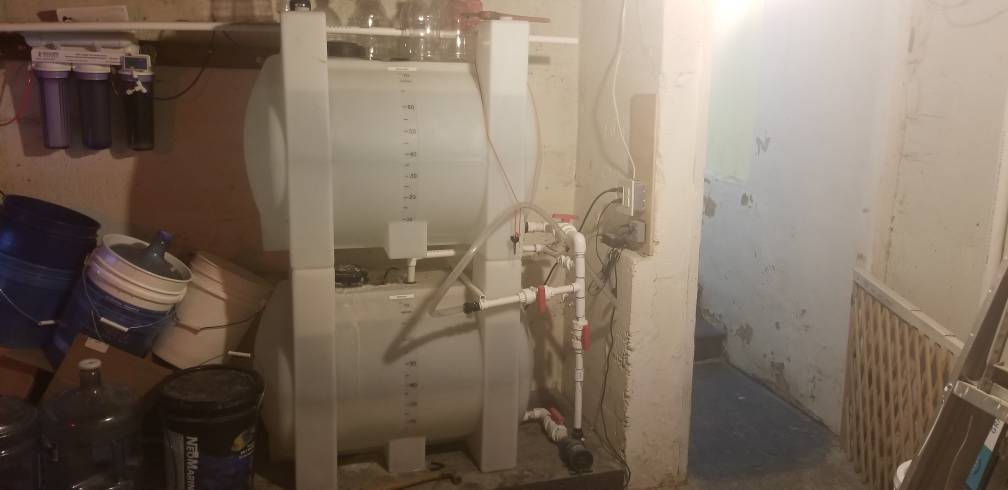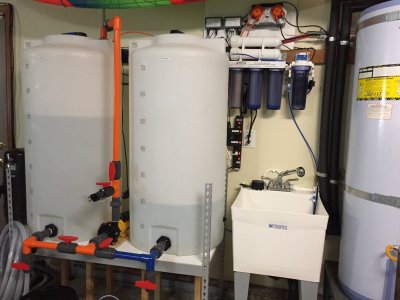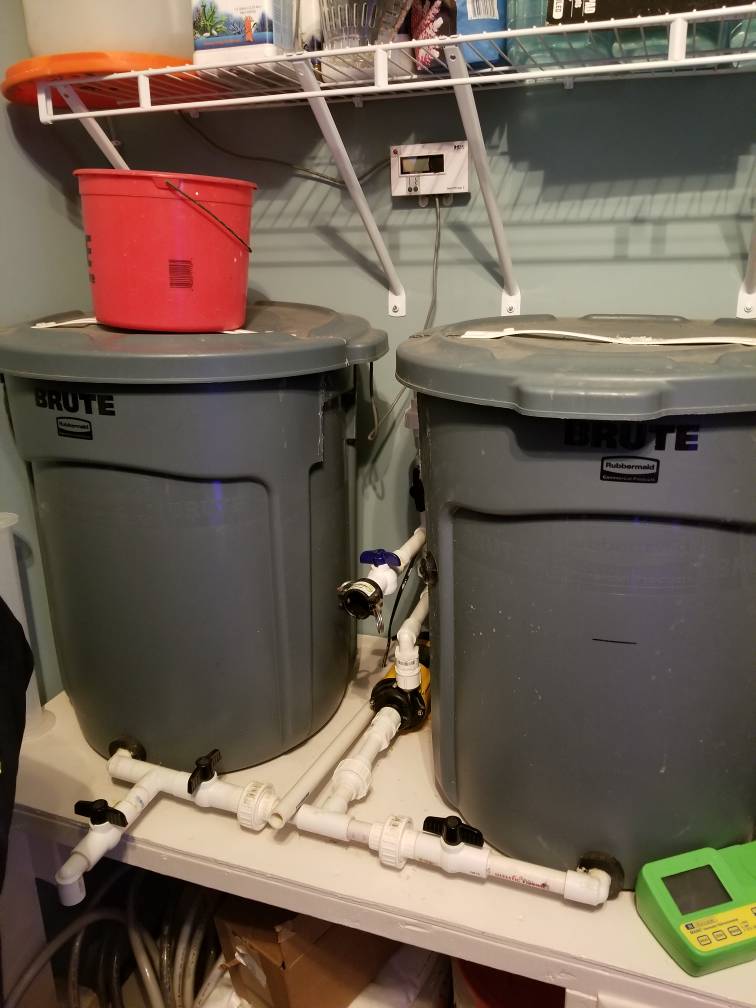- Joined
- Dec 8, 2017
- Messages
- 1,271
- Reaction score
- 1,704
Hi guys! I'm sorry in advance this is so long ;-)
I would really like to put together one of those two bucket watch change/mixing stations and I'd really like to ask some questions, please. I'm really looking for something fairly simple but safe, nothing overly complex, I just want fresh RODI and saltwater on hand. I've already done quite a lot of searching for these stations, and I've looked at many examples, some very complex, but in my research I can't find anyone that has gone into detail about all the various valves and safeguards that you obviously need for these setups. So my first question right off the top is: does anyone know of a good writeup/diagram/video that DETAILS all the various fittings used in a typical system? I'm talking about things beyond RO fittings and bulkheads, I'm talking about the safety devices that can minimize flooding. That would be really helpful!
Beyond that, let me mention that I have a simple, budget RO system under the kitchen sink for the house, and had purchased the BRS Dual DI kit to add to this when I decided to get back into reefing. However, a few weeks ago I found a forum member offering a used BRS 75gpd 6 stage system, and I will be using this system for my water change station. I purchased the used BRS 6 stage system, I also ordered from BRS the Matrix media kit and a replacement Dow RO membrane. I also purchased the BRS 150gpd upgrade kit. Additionally, I happen to have already a brand new HM Digital TDS meter that gives 3 readings, and I have a brand new psi gauge I want to use. Again, I'm looking for a simple two bucket system, almost certainly Brute cans, maybe 20-44 gallons each.
A couple quick RO filter questions, please: Keeping in mind I will be using the BRS 150gpd upgrade kit, running 2 RO membranes in series, I *believe* I want my psi gauge to be right before the first RO membrane. Is this correct? And, given that I have a TDS meter with three probes, where do you suggest I place those probes in my 7 stage system? For the fairly low cost of the meters, is there any value in getting another TDS meter to read at any other points in my system?
As far as the RO filter setup itself, I really want to do it right, and the more I research, the more confused I get, lol! I plan on setting up my system in our basement laundry room right over our "slop sink" (you know those basement sinks every home has). This room is also my very humble woodworking shop, and although I'm not a great woodworker, and don't have the most expensive tools, it would be devastating to me personally if I had a flood in this room and damaged any of my machines, materials I'm saving, or frankly anything else. That said, the saving grace is that if you were standing directing in front of my sink, our laundry washer is directly left of the sink, and our sump-pump area is directly left of the washer. Therefore, I *believe* any flooding would likely run into the sump, and never really gain much depth at all, but I still really want to avoid any floods ;-)
I have heard tale of solenoids being used to be able to shut off the source water is case of flooding. This I would really appreciate some help with. What/where are these devices? What other redundant backups and safegaurds are people using to avoid flooding when putting these water change stations together?
Some additional RO filter questions, just in general: I expect to have fairly high pressure at the site where I'm installing the filter, and I'll know for sure when I get it up and running with the psi gauge in place. I know to use my 150gpd upgrade kit I need a good 65psi, and if I don't see that I'll get a booster pump, but what if my pressure is too high? Is this where a flow restrictor comes in play? I expect that my source water will be very cold, I'm guessing 50's degrees F. How do you guys suggest I get that closer to the 70F range the RO membrane expects?
How do you handle things like flushing the RO membrane and TDS creep in a setup like I'm describing (ie a two bucket water change station) where the RO filter is permanently connected in place? Is it true that you want to run the RO filter system maybe once a week, making all your water at once, instead of having the filter system come on and turn off several times (such as if "topping up" all the time)? Strictly from the point of view of RO filter efficiency, the first way is best, right? Basically, turn on filter, bleed off high TDS initial output (TDS creep), fill water reservoirs, flush RO membrane, shut down filter. Is this the best way to run the system?
I have seen many systems where the second bucket is gravity fed from the first bucket with some PVC parts and valves. On a BRS video they simply have a three way valve that can be set so it fills each bucket, and, of course, each bucket has a float valve. To me, the BRS setup seems easier, but in my research I saw more people doing it the other way. Other than for space saving reasons, is there any benefit to having the second bucket gravity fed with water from the first bucket, or does anyone else use the method I saw on the BRS video?
Wow, sorry again this is so long, but I would really appreciate some help putting my system together. If anyone has any thoughts, please let me know.
Thank you for your help!
-FishFan
I would really like to put together one of those two bucket watch change/mixing stations and I'd really like to ask some questions, please. I'm really looking for something fairly simple but safe, nothing overly complex, I just want fresh RODI and saltwater on hand. I've already done quite a lot of searching for these stations, and I've looked at many examples, some very complex, but in my research I can't find anyone that has gone into detail about all the various valves and safeguards that you obviously need for these setups. So my first question right off the top is: does anyone know of a good writeup/diagram/video that DETAILS all the various fittings used in a typical system? I'm talking about things beyond RO fittings and bulkheads, I'm talking about the safety devices that can minimize flooding. That would be really helpful!
Beyond that, let me mention that I have a simple, budget RO system under the kitchen sink for the house, and had purchased the BRS Dual DI kit to add to this when I decided to get back into reefing. However, a few weeks ago I found a forum member offering a used BRS 75gpd 6 stage system, and I will be using this system for my water change station. I purchased the used BRS 6 stage system, I also ordered from BRS the Matrix media kit and a replacement Dow RO membrane. I also purchased the BRS 150gpd upgrade kit. Additionally, I happen to have already a brand new HM Digital TDS meter that gives 3 readings, and I have a brand new psi gauge I want to use. Again, I'm looking for a simple two bucket system, almost certainly Brute cans, maybe 20-44 gallons each.
A couple quick RO filter questions, please: Keeping in mind I will be using the BRS 150gpd upgrade kit, running 2 RO membranes in series, I *believe* I want my psi gauge to be right before the first RO membrane. Is this correct? And, given that I have a TDS meter with three probes, where do you suggest I place those probes in my 7 stage system? For the fairly low cost of the meters, is there any value in getting another TDS meter to read at any other points in my system?
As far as the RO filter setup itself, I really want to do it right, and the more I research, the more confused I get, lol! I plan on setting up my system in our basement laundry room right over our "slop sink" (you know those basement sinks every home has). This room is also my very humble woodworking shop, and although I'm not a great woodworker, and don't have the most expensive tools, it would be devastating to me personally if I had a flood in this room and damaged any of my machines, materials I'm saving, or frankly anything else. That said, the saving grace is that if you were standing directing in front of my sink, our laundry washer is directly left of the sink, and our sump-pump area is directly left of the washer. Therefore, I *believe* any flooding would likely run into the sump, and never really gain much depth at all, but I still really want to avoid any floods ;-)
I have heard tale of solenoids being used to be able to shut off the source water is case of flooding. This I would really appreciate some help with. What/where are these devices? What other redundant backups and safegaurds are people using to avoid flooding when putting these water change stations together?
Some additional RO filter questions, just in general: I expect to have fairly high pressure at the site where I'm installing the filter, and I'll know for sure when I get it up and running with the psi gauge in place. I know to use my 150gpd upgrade kit I need a good 65psi, and if I don't see that I'll get a booster pump, but what if my pressure is too high? Is this where a flow restrictor comes in play? I expect that my source water will be very cold, I'm guessing 50's degrees F. How do you guys suggest I get that closer to the 70F range the RO membrane expects?
How do you handle things like flushing the RO membrane and TDS creep in a setup like I'm describing (ie a two bucket water change station) where the RO filter is permanently connected in place? Is it true that you want to run the RO filter system maybe once a week, making all your water at once, instead of having the filter system come on and turn off several times (such as if "topping up" all the time)? Strictly from the point of view of RO filter efficiency, the first way is best, right? Basically, turn on filter, bleed off high TDS initial output (TDS creep), fill water reservoirs, flush RO membrane, shut down filter. Is this the best way to run the system?
I have seen many systems where the second bucket is gravity fed from the first bucket with some PVC parts and valves. On a BRS video they simply have a three way valve that can be set so it fills each bucket, and, of course, each bucket has a float valve. To me, the BRS setup seems easier, but in my research I saw more people doing it the other way. Other than for space saving reasons, is there any benefit to having the second bucket gravity fed with water from the first bucket, or does anyone else use the method I saw on the BRS video?
Wow, sorry again this is so long, but I would really appreciate some help putting my system together. If anyone has any thoughts, please let me know.
Thank you for your help!
-FishFan



















